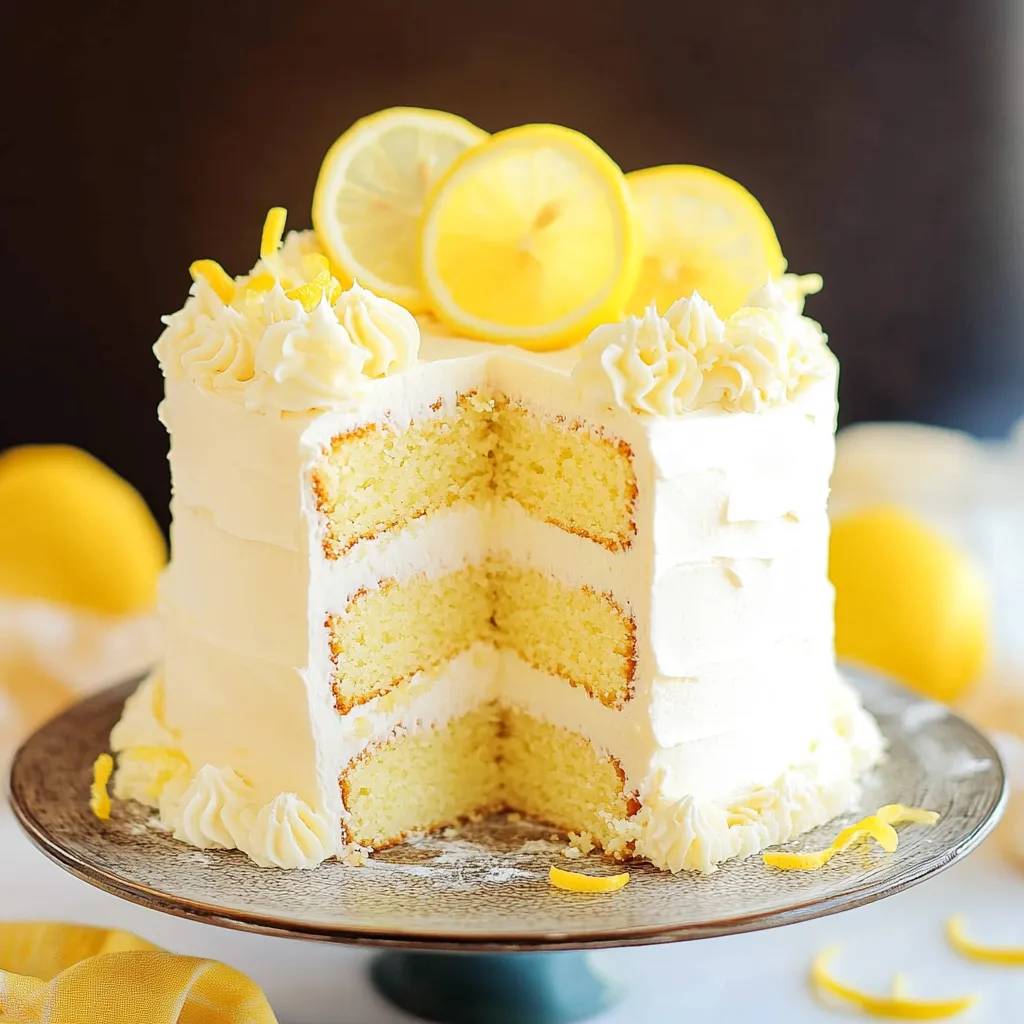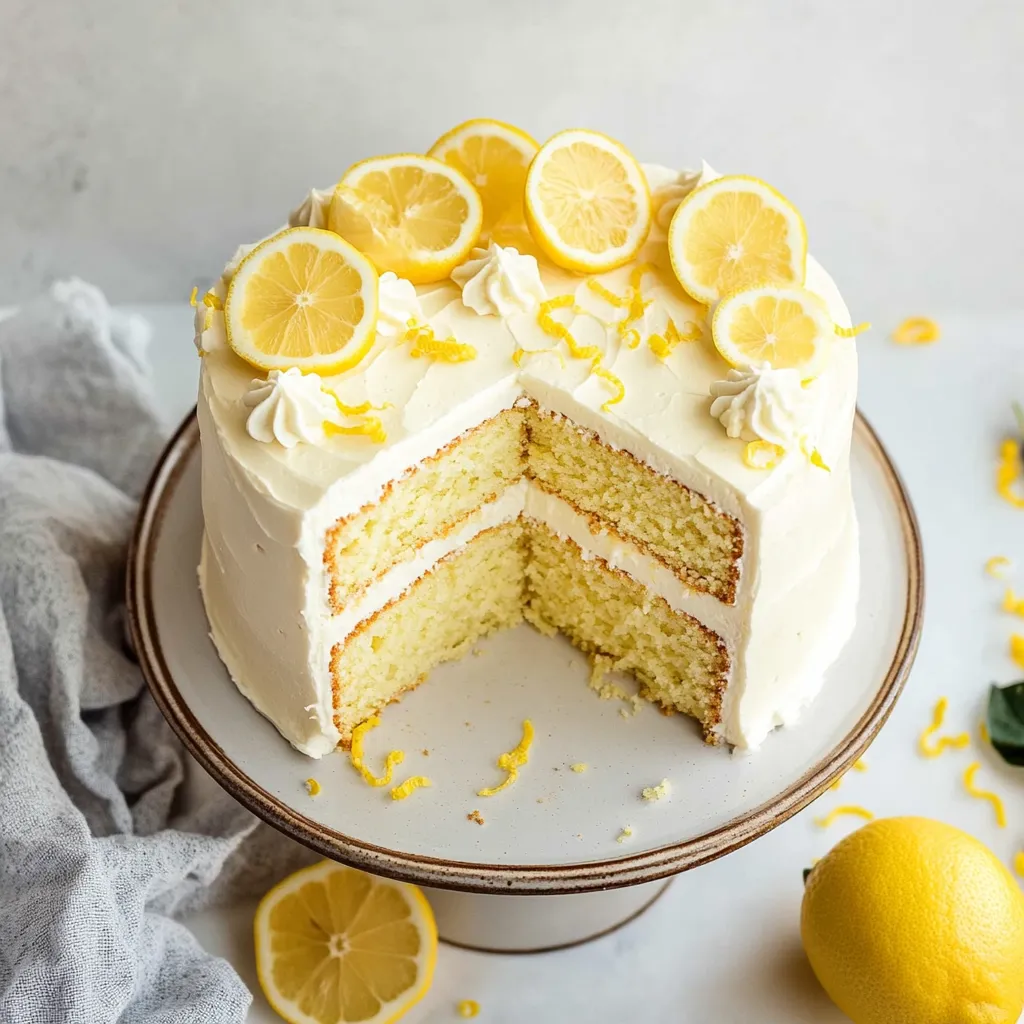 Pin
Pin
This luscious lemon cake combines bright citrus flavors with a light, fluffy texture that will brighten any occasion. The homemade lemon curd nestled between tender cake layers creates an unforgettable dessert that balances sweet and tangy notes perfectly.
I first made this cake for my sister's spring birthday gathering, and it quickly became the most requested dessert at family celebrations. The bright yellow color and fresh flavor always brings a bit of sunshine to our table, even in winter months.
Ingredients
- All-purpose flour: Forms the foundation of this tender cake
- Baking powder: Provides the perfect rise for light and fluffy layers
- Fresh lemons: Essential for authentic flavor in both cake and curd
- Unsalted butter: Allows you to control the saltiness while adding richness
- Granulated sugar: Balances the tartness of the lemons
- Eggs: Provide structure and richness to both cake and curd
- Vanilla extract: Adds depth without overpowering the lemon
- Milk: Creates the perfect tender crumb texture
Step-by-Step Instructions
- Prepare the Pans:
- Preheat oven to 350°F and prepare three 6-inch cake pans with grease, flour and parchment paper. This triple protection ensures your cakes will release perfectly after baking without any stuck spots that could ruin your beautiful layers.
- Mix Dry Ingredients:
- Whisk together flour, baking powder, and salt in a medium bowl until evenly distributed. This prevents any pockets of salt or baking powder that could create inconsistent texture in your finished cake.
- Cream Butter and Sugar:
- Beat the butter and lemon zest until smooth, then add sugar and beat on medium-high for a full three minutes until very pale and fluffy. This extended creaming creates air pockets that give the cake its light texture and is crucial for tender layers.
- Add Eggs and Vanilla:
- Reduce mixer speed and add eggs one at a time, allowing each to fully incorporate before adding the next. This prevents the mixture from curdling and ensures even distribution throughout the batter. Add vanilla after all eggs are incorporated.
- Combine Wet and Dry Ingredients:
- Alternate adding flour mixture with milk and lemon juice in specific order, beginning and ending with flour. This method prevents overmixing and creates the perfect cake texture. Use gentle folding motions toward the end to maintain airiness.
- Bake to Perfection:
- Spread batter evenly between prepared pans, smoothing the tops with an offset spatula. Bake for approximately 30-35 minutes until a toothpick inserted comes out mostly clean. The cakes should spring back slightly when touched and begin to pull away from the sides of the pans.
 Pin
Pin
The homemade lemon curd truly elevates this cake beyond ordinary lemon desserts. I spent years trying different recipes before perfecting this version, which strikes the ideal balance between sweet and tart. My grandchildren always fight over who gets to lick the spoon when I make this bright yellow treasure.
Mastering Lemon Curd
Creating silky smooth lemon curd requires constant attention. The key is low, steady heat and continuous whisking to prevent the eggs from scrambling. Watch for the mixture to coat the back of a spoon and leave a clear path when you run your finger through it. This visual cue indicates perfect thickness better than timing alone.
Ermine Frosting Tips
This old-fashioned frosting style, sometimes called boiled milk frosting, offers the perfect complement to tart lemon cake. Unlike American buttercream, it has a silky texture that feels light on the palate. The flour mixture must cool completely before adding butter, or you will end up with a soupy mess. Test by touching the bottom of the bowl, which should feel completely room temperature with no warmth whatsoever.
Decorating Success
For professional looking results, use a cake turntable when frosting the exterior. Apply frosting generously, then remove excess with a bench scraper held at a slight angle while turning the cake. The thin lemon slices around the base add visual interest and hint at the flavors inside. For the cleanest cuts, freeze the assembled cake for 20 minutes before serving, and use a hot knife wiped clean between slices.
Storage and Make-Ahead Options
The complete cake can be stored refrigerated for up to three days. The lemon curd and ermine frosting can be made up to a week ahead and stored separately in airtight containers. Unfrosted cake layers freeze beautifully for up to two months when wrapped tightly in plastic and aluminum foil. This makes it perfect for advance preparation before special occasions.
Recipe Questions & Answers
- → How do I ensure the cake layers are moist?
Alternate adding flour with milk and lemon juice, starting and ending with the flour mixture. Avoid overmixing and use fresh ingredients for the best results.
- → Can I make the lemon curd ahead of time?
Yes, you can make the lemon curd up to two days in advance. Store it in the fridge with plastic wrap laid directly on the surface to prevent a skin from forming.
- → What is the best way to frost the cake?
Start with a crumb coat to lock in crumbs, chill the cake for 20 minutes, then apply the final frosting layer. Use an icing scraper to smooth the sides for a professional finish.
- → Can I substitute the frosting with another type?
Absolutely! Cream cheese frosting or whipped cream can work as substitutes, but the vanilla ermine frosting complements the lemon flavors beautifully.
- → How can I decorate this cake for special occasions?
Garnish the top with rosette dollops of frosting, thin lemon slices, and a sprinkle of lemon zest for an elegant touch. Fresh flowers also make a lovely addition.
- → Can this cake be made gluten-free?
Yes, substitute the all-purpose flour with a 1:1 gluten-free baking flour blend. Ensure all other ingredients are gluten-free as well.